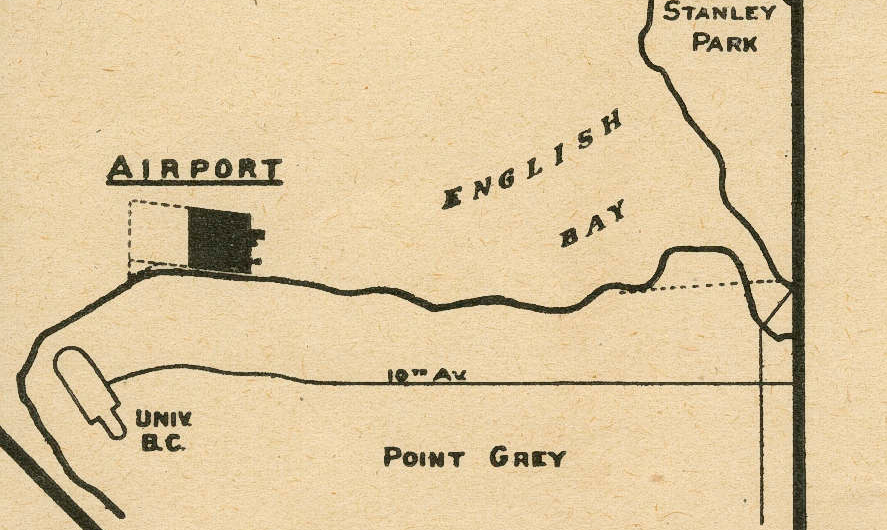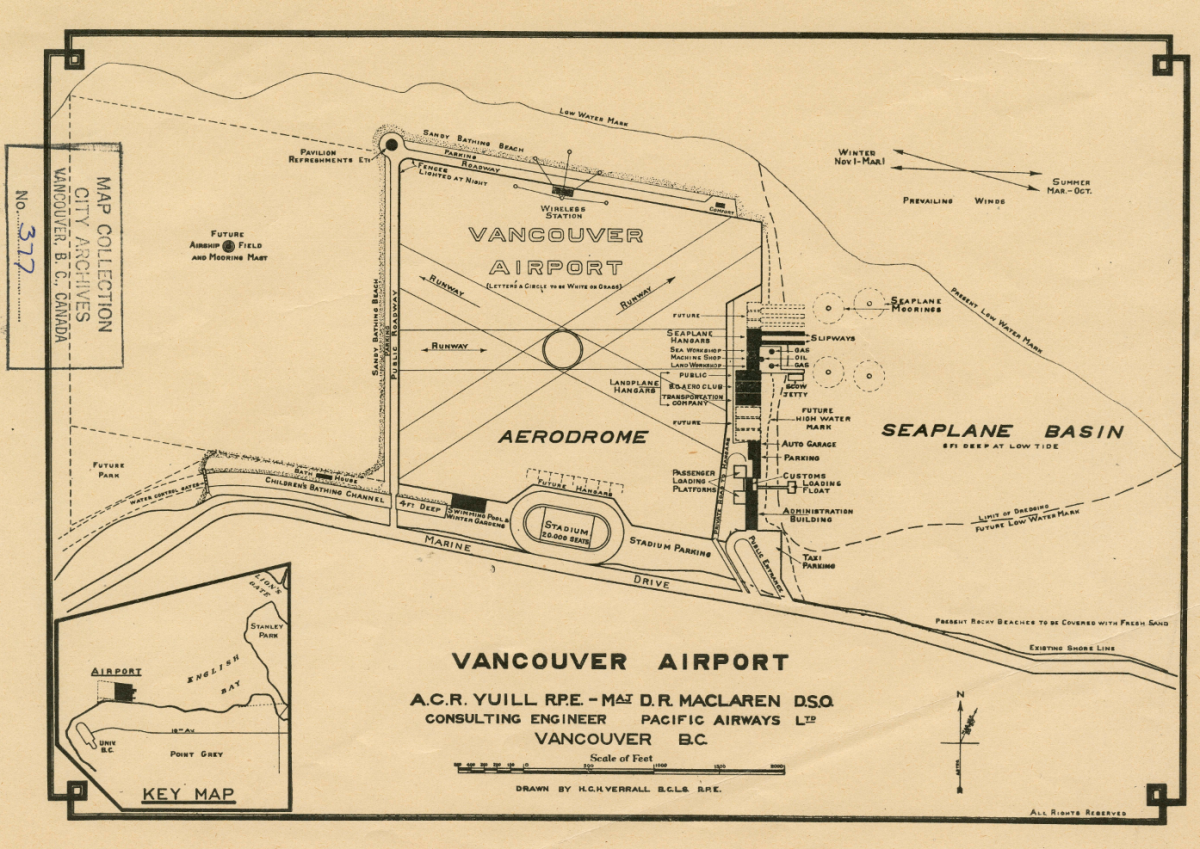It all started with Charles Lindbergh.

One of history’s most famous aviators, Lindbergh – who set a record by making a non-stop, solo, trans-Atlantic flight from New York to Paris in 1927 – was invited to visit Vancouver that year. The celebrity declined, famously saying “there is no fit field to land on.”
It was true at the time. Vancouver – a hilly town on the edge of Burrard Inlet – had no airport.
Lindbergh’s snub sparked city planners into action. What followed was several years of planning that eventually led to the opening of Vancouver International Airport in Richmond in 1931.
But Sea Island wasn’t the only place planners had in mind. In fact, one proposal would have placed the airport much closer to home, and it would have permanently changed the landscape and geography of Vancouver.
Spanish Banks.
That was the idea behind a 1928 proposal that suggested building the airport, along with a large stadium and park, on Spanish Banks, the current seaside gem of Vancouver’s West Side.
Looking back, the plan seems like a bizarre April Fool’s joke, but in the late ’20s, it was a real possibility and was poised to solved a few city issues.
Just three years before Vancouver Airport officially opened on Sea Island in Richmond, Pacific Airways Ltd. submitted a proposal that called for a three-runway airport and seaplane harbour to be built on mostly infilled land where Spanish Banks beach currently sits.
Behind the airport on Marine Drive would be a 20,000-seat stadium, roughly the capacity of Rogers Arena. That would be complemented to the west by swimming pools and “Winter Gardens”, a bathhouse, children’s bathing channel, and a park.
Directly west of the airport would be an airship field and mooring mast. On the north shoreline would be a sandy bathing beach and on the east, the shoreline would be pushed back to allow for a seaplane basin.
The budget for the plan was estimated at $466,000 for requirements to 1930 and $1.25 million with requirements to 1940. The stadium would cost a further $200,000, winter gardens would be $300,000, the airship field would add $800,000 and the beach and park would cost $100,000.
The total cost? Between $1.8 million and $2.6 million. Adjusted for inflation, that’s between $26 million and $36 million in 2016 dollars.
A search couldn’t find any records of the plan being discussed at Point Grey council (the district was a separate municipality until 1929), but common sense suggests the plan was tossed aside in favour of Sea Island, where some aviation infrastructure was already in place at Minoru Park.
Richmond was farther from the city, but the land was cheaper, bigger and also adjacent to a waterway suitable for seaplanes.
There’s no doubt the City made the right choice. Now with three runways, two terminals and 22 million passengers a year, the airport’s present-day traffic would not have been managed at the Spanish Banks location – measured at about 2,500 feet in width.
But it wasn’t the most preposterous idea at the time.
Patrick Condon, chair of the Urban Design program at the University of British Columbia, says the beach was a natural place for planners to look.
“Flat space is at a premium around here. It would take some filling in, but not too much,” Condon said.
It was also adjacent to the Royal Canadian Air Force station at Jericho Beach, where Jericho Sailing Centre currently operates.
Left: Jericho Air Station, date unknown. Right: Mayor L.D. Taylor, Major Tudhope and Captain Glover of the B.C. Electric Railway Company in front of a seaplane at the Jericho Beach Station, 1926. Photos: City of Vancouver Archives
The idea, he said, was similar to airports like La Guardia and John F. Kennedy that would be built in New York over the next two decades. It was also analogous to Los Angeles International Airport which began development in 1928 bordering a long stretch of beach on the city’s west side.
“I suppose they had aspirations down at LAX to create a wonderful event out of the intersection of a bathing beach and an airport, but in those days no one had any idea about the growth of air travel and how being next to an airport isn’t the most pleasant experience,” Condon added.
In Vancouver, it wouldn’t have just been beach-goers situated next to the airport.
The surrounding area was home to thousands of residents and many posh estates. With a third of Point Grey owned by Canadian Pacific Railway, it was where a lot of the city’s money came to reside. The expanded University of British Columbia campus was also growing at rapid pace further west along Marine Drive.
The proposed 20,000-seat stadium may have been tailored to those people. The only other arena in Vancouver at the time was Denman Arena in the West End that seated 10,500 people. It is likely that planners envisioned the Spanish Banks area would become an entertainment hub where residents could come down to enjoy the seaside, catch a show or sporting event and watch planes take off (it was a popular pastime in those days).
Had their vision come to fruition, Vancouver would not have had the acres of park land, unspoiled beaches and seaside recreation it does today in that area. With the expected expansion of the airport along with the growth in air travel, Condon says runways could have eventually been built jutting out into English Bay.
Any effect this would have on Vancouver’s port traffic and busy marine hub can only be speculated upon
But there is no doubt Vancouver – and Richmond – would have developed quite differently.
A rough estimate of the proposed airport at Spanish Banks. Plan drawings seem to place the development on the west end of Spanish Banks below Pacific Spirit Park.









Comments